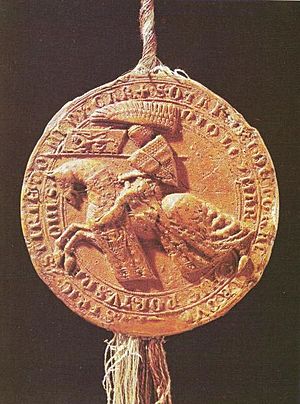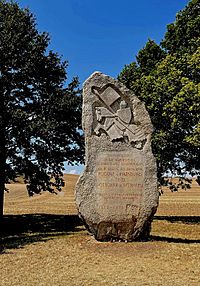Ottokar II of Bohemia facts for kids
Quick facts for kids Ottokar II |
|
|---|---|

Ottokar's royal seal
|
|
| King of Bohemia | |
| Reign | 23 December 1253 – 26 August 1278 |
| Coronation | 1261, Prague |
| Predecessor | Wenceslaus I |
| Successor | Wenceslaus II |
| Born | c. 1233 Městec Králové, Bohemia |
| Died | 26 August 1278 (aged c. 44–45) Dürnkrut, Austria |
| Burial | Saint Vitus Cathedral |
| Spouse | Margaret of Austria Kunigunda of Slavonia |
| Issue more... |
Kunigunde of Bohemia Wenceslaus II of Bohemia (illeg.) Nicholas I of Troppau |
| Dynasty | Přemyslid |
| Father | Wenceslaus I of Bohemia |
| Mother | Kunigunde of Hohenstaufen |
Ottokar II (Czech: Přemysl Otakar II.) was a powerful king of Bohemia from 1253 to 1278. He was born around 1233 in Městec Králové, Bohemia, and died in battle on August 26, 1278, in Dürnkrut, Austria. People called him the Iron and Golden King because he was a strong warrior and very rich.
Ottokar was part of the Přemyslid dynasty, a royal family. Besides being King of Bohemia, he also ruled over other lands. These included Moravia (from 1247), Austria (from 1251), Styria (from 1260), and later Carinthia and Carniola (from 1269). Under his rule, the Přemyslid family became very powerful in the Holy Roman Empire. He hoped to become the Emperor himself, but this never happened.
Ottokar was the second son of King Wenceslaus I of Bohemia. His mother, Kunigunde of Hohenstaufen, was related to the Hohenstaufen dynasty, a famous family of Holy Roman Emperors. Ottokar was named after his grandfather, King Ottokar I of Bohemia. He was first trained to be a church leader, as his older brother, Vladislaus, was expected to be the next king.
Contents
Becoming King
In 1247, Ottokar's older brother Vladislaus died suddenly. This meant Ottokar became the new heir to the Bohemian throne. His father made him the ruler of Moravia. Ottokar moved to Brno and helped rebuild the lands that had been damaged by Mongol raids in 1242.
In 1248, some nobles who were unhappy with King Wenceslaus convinced Ottokar to lead a rebellion. Ottokar was chosen as "the younger King" and briefly took over Prague Castle. However, Pope Innocent IV punished Ottokar by excommunicating him from the church. King Wenceslaus eventually defeated the rebels and put his son in prison.
Soon after, father and son made up. They worked together to gain control of the nearby Duchy of Austria. The last duke of Austria had died in 1246 without a direct heir. In 1251, Ottokar became the governor of Austria with the support of the local nobles. To make his rule official, Ottokar married Margaret of Austria, the sister of the last duke. She was 30 years older than him. They married on February 11, 1252.
In 1253, King Wenceslaus died, and Ottokar became the King of Bohemia. He also hoped to become the King of Germany, but he was not chosen.
Expanding His Kingdom
Ottokar's growing power worried his cousin, King Béla IV of Hungary. Béla formed an alliance and tried to take control of Styria, a region that had been linked to Austria. The Pope helped them make peace. Ottokar agreed to give some parts of Styria to Béla, and in return, Béla recognized Ottokar's right to the rest of Austria.
King Ottokar II also led two crusades against the pagan Old Prussians in 1254–1255 and 1268. The city of Königsberg (now Kaliningrad) was founded in 1255 by the Teutonic Order. It was named in Ottokar's honor and later became an important capital.
The conflict with Hungary started again a few years later. In July 1260, Ottokar defeated the Hungarians at the Battle of Kressenbrunn. This victory ended the disputes over Styria. Béla gave Styria back to Ottokar. To seal the peace, Ottokar ended his marriage to Margaret and married Béla's young granddaughter, Kunigunda of Halych. She became the mother of his children, including his only legitimate son, Wenceslaus II.
During a time when there was no clear ruler for the Holy Roman Empire (1250–1273), Ottokar became even more powerful. In 1266, he took over the Egerland region. In 1268, he made a deal to inherit Carinthia, Carniola, and the Windic March. By 1272, he also gained Friuli. After another victory against the Hungarians, Ottokar was the strongest king in the Holy Roman Empire.
The Final Battle
After the German King Richard of Cornwall died in 1272, a new election for the Imperial throne took place in 1273. Ottokar again tried to become Emperor, but he lost. The electors chose Rudolf of Habsburg, a "little count" who became Ottokar's main rival.
Ottokar refused to accept Rudolf as the new Emperor. In 1274, Rudolf declared that all lands taken since the death of Emperor Frederick II must be returned. This meant Ottokar would lose Austria, Styria, Carinthia, and Egerland. In 1275, Rudolf declared Ottokar an outlaw. Rudolf then attacked Ottokar's palace in Vienna. A rebellion also broke out in Bohemia.
These problems forced Ottokar to sign a new treaty in November 1276. He gave up all his claims to Austria and the other duchies. He kept only Bohemia and Moravia. As part of the peace, Ottokar's son Wenceslaus was engaged to Rudolf's daughter Judith.
Two years later, Ottokar tried to win back his lost lands by force. He gathered a large army with allies from Bavaria, Brandenburg, and Poland. On August 26, 1278, his army met the forces of Rudolf and his ally, King Ladislaus IV of Hungary, at the Battle on the Marchfeld. Ottokar was defeated and killed in this battle. His body was first placed in a church in Vienna. Later, in 1297, his remains were moved to St. Vitus Cathedral in Prague. His 6-year-old son, Wenceslaus II, became the new King of Bohemia.
Family Life
On February 11, 1252, Ottokar II married Margaret of Austria. She was 26 years older than him, and they did not have any children. Their marriage was later ended.
On October 25, 1261, Ottokar married Kunigunda of Slavonia. They had four children:
- Henry (1262–1263)
- Kunigunde (1265–1321), who married Boleslaus II of Masovia.
- Agnes (1269–1296), who married Rudolf II, Duke of Austria.
- Wenceslaus II (1271–1305).
Ottokar also had other children outside of marriage. His most important illegitimate son was Nicholas. Nicholas was never considered an heir to the throne, but he was given the Duchy of Opava to rule in 1269.
Legacy

Ottokar II is remembered as one of Bohemia's greatest kings, alongside Charles IV. He founded many new towns, about 30 in total, across his lands. He also gave special rights to existing towns, which helped trade and law and order. He encouraged skilled German-speaking people to move to his cities. The historic city of Königsberg was named after him because he supported the Teutonic Knights.
During his reign, many important legal changes happened in Bohemia. He introduced new laws that formed the basis of Czech law for centuries. He supported the city of Jihlava with its silver mines, which brought great wealth to later Bohemian kings. He also gave special rights to towns that made them less controlled by nobles, a step towards more equal laws.
Ottokar introduced a law called Emphyteusis in Bohemia. This law freed people from some old feudal duties, meaning they mostly had to pay rent and taxes instead of working for lords. This allowed people to buy and sell land more freely. These changes helped develop Bohemian rights in the Middle Ages.
In 1254, Ottokar issued a special privilege for Jewish people. This law helped Jews become more integrated into Czech society. They could hold various positions and receive support from royal officers, which reduced discrimination.
Ottokar also focused on building strong defenses. He built many castles, like Zvíkov Castle, Křivoklát Castle, and Bezděz Castle in Bohemia, and the famous Hofburg Palace in Vienna. He also encouraged his nobles to build castles. These strongholds were important after the Mongol raids of the 13th century. Ironically, Bezděz Castle later served as a prison for his son, Wenceslaus II, after Ottokar's death.
Before his conflict with Rudolf of Habsburg, Ottokar had influence over many allies and rulers in Germany. He was even appointed protector of the Holy Roman Empire's lands east of the Rhine from 1267 to 1273.
Ottokar is an important figure in history and stories. In Dante's famous poem Divine Comedy, Ottokar is shown peacefully with his rival Rudolf outside the gates of Purgatory. He is also the main character in a play by the Austrian writer Franz Grillparzer. There is also a statue dedicated to him.
Images for kids
-
Burial crown of Ottokar II of Bohemia at Prague Castle
See also
 In Spanish: Otakar II de Bohemia para niños
In Spanish: Otakar II de Bohemia para niños








